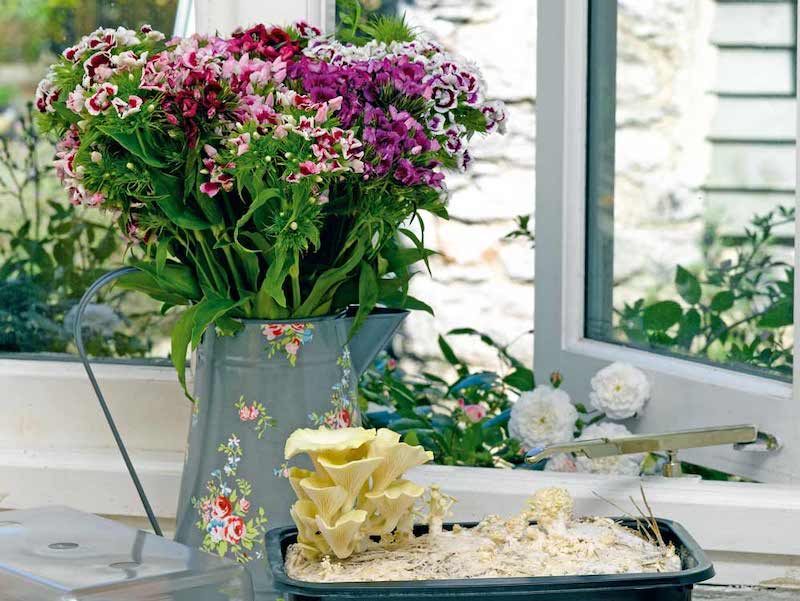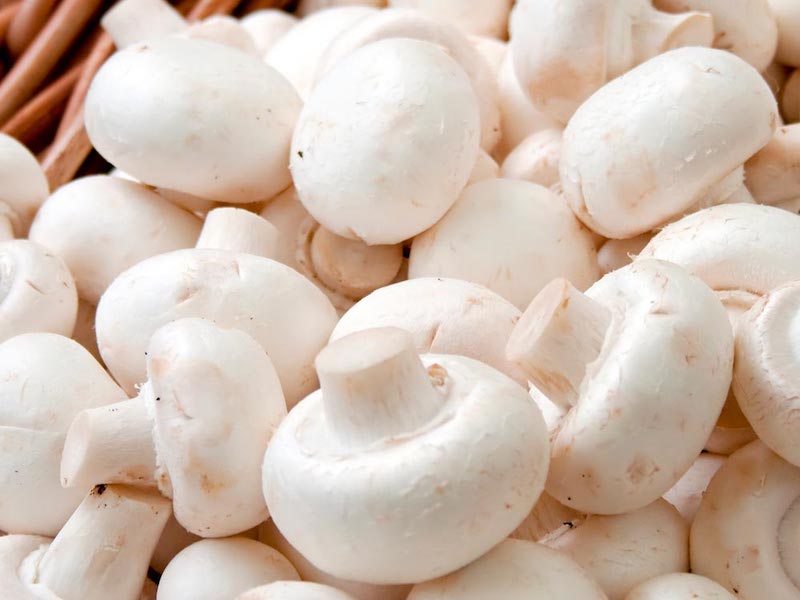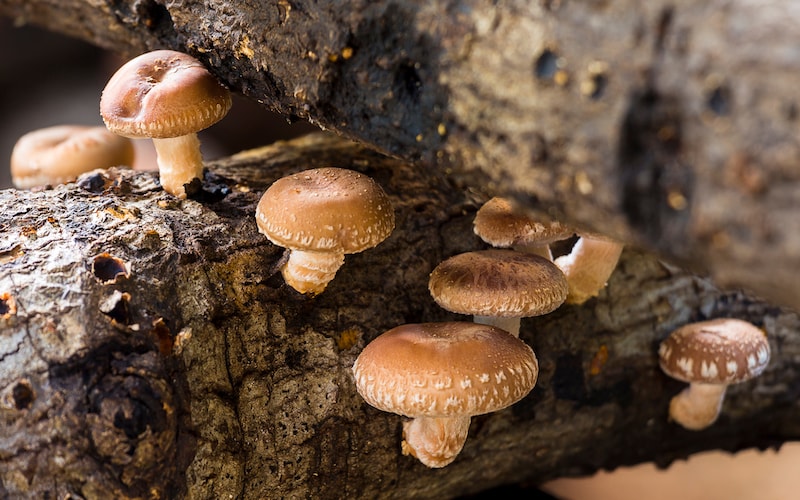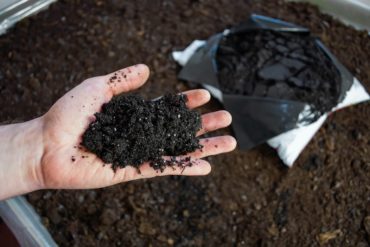Growing your own mushrooms has never been simpler, especially if you learn the lessons these experts have shared about their own mushroom growing exploits. If you want reliable results, then a mushroom windowsill kit is the perfect choice.
If you’re ready to tackle a longer-term growing challenge, then impregnated plugs are ideal for growing mushrooms on logs outdoors. And if you fancy trying mushroom spawn, you can choose your own growing base. Here are the best articles, videos and Instagram posts on growing mushrooms…
Contents
- Best advice on growing mushrooms using a windowsill kit
- Best advice on growing mushrooms using spawn
- Best advice on growing mushrooms in logs using spawn plugs
- Best plot-to-plate mushroom recipes
Best advice on growing mushrooms using a windowsill kit

Image: Mushroom Windowsill Kit – Yellow Oyster from Suttons
Mushroom kits are by far the easiest method to home-grow a host of different varieties – oyster, button, shiitake, chestnut – as clearly explained in our own beginner’s guide to growing mushrooms over at the Suttons’ blog. Do remember to open your kit straight away as different elements need to be stored at optimum temperatures before they’re brought together.
One advantage of using ready-to-grow mushroom kits, as John at Allotment and Gardens reminds us, is that you can start them off whenever you like and enjoy a relatively quick harvest from your windowsill at almost any time of year, providing the conditions are right.
Catherine at Growing Family recommends growing mushrooms from a windowsill kit as a great autumn indoor project with children, so they can still grow their own food when it’s cold out in the garden.
It’s always thrilling when a long-held growing ambition comes to fruition. Becky at @sow_much_more wholeheartedly agrees in her celebratory post revealing a picture of a fine-looking button mushroom – her very first kit-grown harvest, after previous unexplained failures.
Over at @realallotment, the sight of baby oyster mushrooms beginning to sprout from their straw base just a month after following the kit instructions was equally exciting, heralding the forthcoming satisfaction of harvesting fully grown mushrooms.
Kirsty from @the_greenhouse_of_lords has enjoyed multiple successes with growing kits, turning her kitchen into a winter ‘mushroom factory’. Her images of healthy looking button mushrooms and burgeoning oyster mushrooms are definitely encouraging.
Getting good results from a mushroom kit could encourage you to take on a bigger challenge, like the creator of @locallyseasonal, whose first button mushroom adventure has inspired her to learn how to cultivate edible fungi on a larger scale.
Best advice on growing mushrooms using spawn

Image: Mushroom Windowsill Kit – White Button from Suttons
The medium you use to grow mushroom spawn is known as a substrate. Claire at Claire’s Allotment makes her own, mixing garden soil, well-rotted horse manure and a little bit of compost in a large flower pot. She sprinkles spawn over the surface then covers it with damp newspaper and puts the pot in a gloomy part of the greenhouse, spraying periodically to make sure it stays a little damp.
A large airing cupboard makes the perfect incubation spot for a mushroom spawn growing experiment, according to Eve of UK Homesteading. She uses black plastic bags stuffed with straw as a base, some of it soaked or sprayed with hydrated lime to prevent contamination from other fungi, and some left unsterilised. It’s satisfying to see her first harvest of homegrown oyster mushrooms.
Adam at GroCycle is a mushroom specialist and has plenty of valuable in-depth scientific knowledge to share if you want to immerse yourself in, sometimes complex, growing methods. But in his video Easiest Way To Grow Oyster Mushrooms At Home, he simplifies the process by explaining the bare essentials – pre-pasteurised straw or wood pellets as substrate, mushroom spawn, a big plastic bag, the right environment and some patience.
For a simple shopping list and numbered instructions, check out Simon at Garden of Eaden’s easy to follow guide to growing button mushrooms at home. He uses a 2ft x 3ft growing tray, approximately 6-8in deep and a mushroom compost – ready mixed or homemade from a variety of well-rotted ingredients. He reckons you can get an endless supply for three to six months using his methods.
If searching for the right substrate sounds like hard work, how about growing mushrooms on an old book like Mark Diacono fromThe English Garden. His daughter was growing oyster mushrooms on a discarded paperback, which involves wetting the paper, adding spawn and keeping the book in a plastic bag, to be checked weekly for progress.
Anyone with lofty mushroom growing ambitions can take inspiration from Sid at Sid Hill Ecological Gardens, whose aim is to naturalise oyster mushrooms in his edible forest garden. He gets started by making a new border with breeze blocks in a spot with dappled shade in the garden, laying down a cardboard mulch, followed by wood chips from a local tree surgeon, soaked to kill off aerobic microbes.
Once your mushrooms begin to sprout, they can develop very rapidly over just four or five days, doubling in size every 24 hours, as this great time-lapse oyster mushroom video from Diana at @good_life_garden illustrates.
Best advice on growing mushrooms in logs using spawn plugs

Image: Suttons
Careful selection and preparation of logs is essential if you want to achieve a good mushroom harvest using spawn plugs, says Tony at Simplify Gardening. His excellent step-by-step video shows the whole process – from choosing the right length and diameter of fresh cut logs, through to soaking them, scrubbing them clean and drilling holes for the plugs. He then shows you how to seal the filled holes with wax before leaving them in a dark place for mycelium to develop.
Establishing a colony of mushroom mycelium can take between six to 18 months, warns Simon of Garden of Eaden – so don’t hold your breath! In his very informative article on growing oyster mushrooms, he stresses that logs you use to plant spawn plugs should be cut from a living tree in the dormant season. After achieving your first four-week harvest, and remembering to give your mycelium adequate recovery time, you can expect four to six years of productivity from each log, so he reckons it’s definitely worth the initial effort.
You need to invest time and effort into the log and spawn plug method for growing your own mushrooms, but if you persevere with the setting-up process – as documented by The Good Life Crewe – you should be rewarded well. They found the most frustrating part was trying to drill multiple holes into three big logs with a power tool that quickly ran out of battery power, before hammering in the plugs.
Teaming up with plot neighbours, Sue and Martyn at Green Lane Allotments decided to grow shiitake and oyster mushrooms using plugs and logs, but were still waiting patiently for signs of life two months later. The neighbours, meanwhile, enjoyed speedier results with a spawn-impregnated mini straw bale kit.
Best plot-to-plate mushroom recipes

Image: Mushroom Windowsill Kit – Oyster from Suttons
Now you have your mushrooms, how are you going to cook them? Endlessly versatile and a vegetarian staple, the sky’s the limit for their culinary potential. Mushrooms work really well in a curry, according to Andrew of Life on Pig Row. He shares his recipe for economical homemade tikka masala paste to use with any seasonal vegetable from your plot. In this instance he cooks up button mushrooms with chicken, courgettes and tikka paste for a deliciously spicy supper dish.
For something really adventurous, you could opt to rustle up this Japanese cuisine inspired spring recipe from grower and forager Lizi at Plot and Lane – wild garlic, mushroom and magnolia petal gyoza.
Laurie from @freedomforestlife shares a short video of how she and Dan serve their amazing homegrown oyster mushrooms. She blitzes up some flavoursome herbs and spices with chili and onion to make a punchy Jamaican jerk seasoning. After marinating the sliced mushrooms, she simply pan fries them.
John at Allotment and Garden combines mushrooms with homegrown vegetables and herbs – leeks, onion, garlic, chives and parsley, plus lemons, parmesan and rice from the store cupboard – for his appealing Italian-style leek, mushroom and lemon risotto.
If you’ve been thinking about growing mushrooms, there’s every reason to give it a go this autumn and winter. With such excellent inspiration and advice to draw on – and a variety of methods to suit all levels of interest, confidence and patience – you could soon be harvesting your very own button, shiitake, chestnut or oyster mushrooms, ready to make magic in the kitchen.
Lead image: Mushroom Windowsill Kit – Oyster from Suttons
Last Updated on October 30, 2025 by Suttons Horticultural Team






Hi Gardenah, we are so pleased to hear that our article has inspired you to grow mushrooms. We hope you enjoy the process.
Best regards,
The Suttons Team
I used not to love mushrooms, but from this photos in the article, they really look beautiful. I will try at my garden, Thanks for sharing.